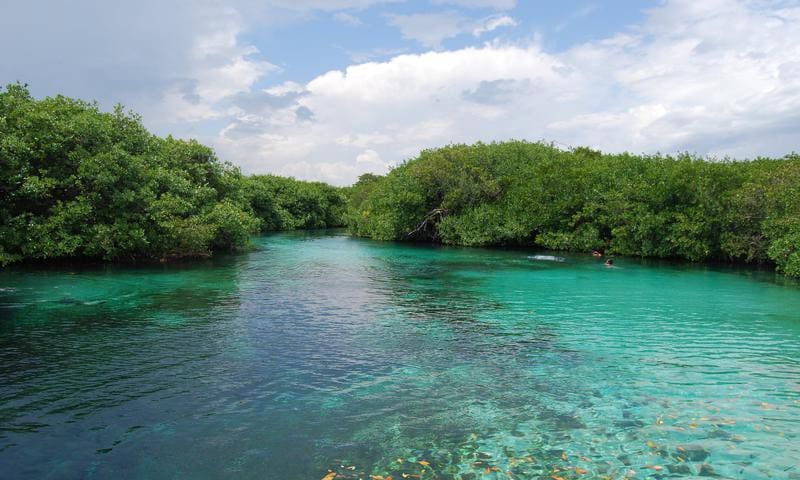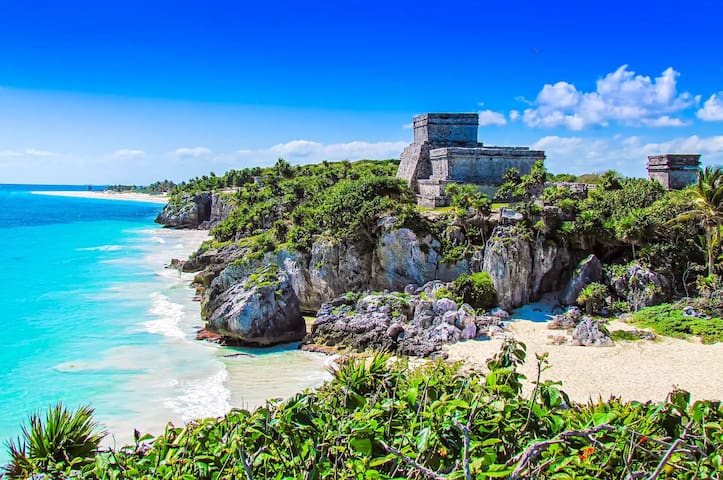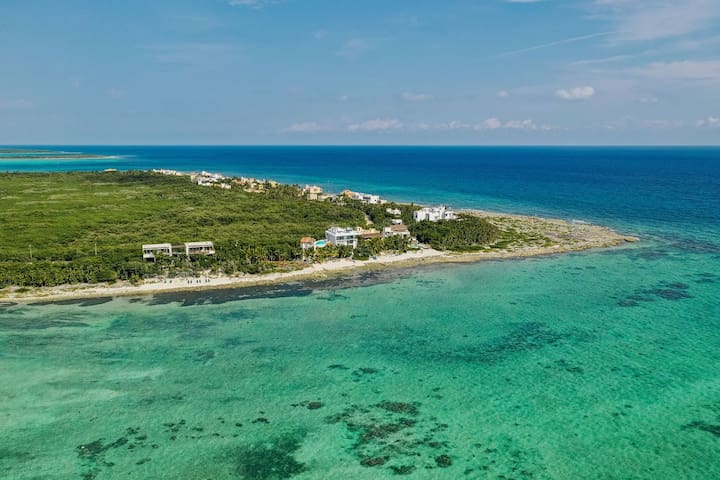Lugares emblemáticos
Near the Tulsayab, an immense ecosystem of mangroves develops, in some parts sprout water eyes (springs) that fill the spaces with fresh water. This place is not exactly a cenote since it does not have characteristics similar to an underground cavern, but many consider it for its tunnels and caves under the mangrove.
The mangroves are very special, the organisms of these ecosystems adapted to an environment of fresh and salt water at the same time.
This cenote is an excellent place to observe the biodiversity that exists in the mangroves; algae, rock formations, various fish, birds and crustaceans.
This cenote is very close to the sea and for that reason its water is brackish, allowing the life of many marine and freshwater organisms, it is possible to observe small crocodiles, a great variety of fish and birds.
It is possible to do cave diving in the tunnels that extend below the mangrove (service hired in diving agencies), in the place it is possible to rent life vests, kayaks for a drier ride and also paddle boards.
25 當地人推薦
Cenote Manatí
Mz. 3 Carr. Cancún - TulumNear the Tulsayab, an immense ecosystem of mangroves develops, in some parts sprout water eyes (springs) that fill the spaces with fresh water. This place is not exactly a cenote since it does not have characteristics similar to an underground cavern, but many consider it for its tunnels and caves under the mangrove.
The mangroves are very special, the organisms of these ecosystems adapted to an environment of fresh and salt water at the same time.
This cenote is an excellent place to observe the biodiversity that exists in the mangroves; algae, rock formations, various fish, birds and crustaceans.
This cenote is very close to the sea and for that reason its water is brackish, allowing the life of many marine and freshwater organisms, it is possible to observe small crocodiles, a great variety of fish and birds.
It is possible to do cave diving in the tunnels that extend below the mangrove (service hired in diving agencies), in the place it is possible to rent life vests, kayaks for a drier ride and also paddle boards.
Tulum Ruins, 9.0 km from Tulsayab, is the site of a Pre-Columbian Maya walled city serving as a major port for Coba.
The ruins are situated on 12 meter (39 ft) tall cliffs, along the east coast of the Yucatan Peninsula on the Caribbean Sea in the state of Quintana Roo, Mexico.
Tulum was one of the last cities built and inhabited by the Maya; it was at its height between the 13th and 15th centuries and managed to survive about 70 years after the Spanish began occupying Mexico. Old World diseases brought by the Spanish settlers appear to have resulted in very high fatalities, disrupting the society and eventually causing the city to be abandoned.
One of the best-preserved coastal Maya sites, Tulum is today a popular site for tourists.
514 當地人推薦
Ruinas de Tulum
Tulum Ruins, 9.0 km from Tulsayab, is the site of a Pre-Columbian Maya walled city serving as a major port for Coba.
The ruins are situated on 12 meter (39 ft) tall cliffs, along the east coast of the Yucatan Peninsula on the Caribbean Sea in the state of Quintana Roo, Mexico.
Tulum was one of the last cities built and inhabited by the Maya; it was at its height between the 13th and 15th centuries and managed to survive about 70 years after the Spanish began occupying Mexico. Old World diseases brought by the Spanish settlers appear to have resulted in very high fatalities, disrupting the society and eventually causing the city to be abandoned.
One of the best-preserved coastal Maya sites, Tulum is today a popular site for tourists.
Tankah Bay is a protected area, surrounded by jungle and facing the coral reef.
It features an abundance of marine life, animals and birds.
Very common are iguanas, mapaches, sereques, coaties, geckos, pelicans, sea eagle, hummingbirds, crabs, fish of all kinds.
The entire area of Tankah Bay, under strict private surveillance, covers acres and acres of pristine land where mangroves alternate with virgin beaches with the blue of the ocean as background. Diversified flora and fauna abound with a great variety of species within easy reach. In season, flamingos visit the area and storks suddenly appear, while the perennial and high flight of birds of prey scouts the area over every species dwelling in this unique biosphere.
Tankah paradise houses one of the most beautiful and best known Cenote of the entire Q. Roo. It is known as Casa cenote or Cenote manatí, and is only 5 minutes away from the Tulsayab residence. There, pure and captivating waters move-in inside the wood, exposing here and there new places to discover and explore.
Activities such as snorkeling, kayak driving, paddle boarding, diving represent a unique feature of this small paradise. You will find kayaks and beach supplies to discover the bay.
In summary, Tulsayab offers a unique experience, unmatched by any other location in the area, joining the magic of nature with a large variety of services and comfort.
Tulsayab Luxury Development
Tankah Bay is a protected area, surrounded by jungle and facing the coral reef.
It features an abundance of marine life, animals and birds.
Very common are iguanas, mapaches, sereques, coaties, geckos, pelicans, sea eagle, hummingbirds, crabs, fish of all kinds.
The entire area of Tankah Bay, under strict private surveillance, covers acres and acres of pristine land where mangroves alternate with virgin beaches with the blue of the ocean as background. Diversified flora and fauna abound with a great variety of species within easy reach. In season, flamingos visit the area and storks suddenly appear, while the perennial and high flight of birds of prey scouts the area over every species dwelling in this unique biosphere.
Tankah paradise houses one of the most beautiful and best known Cenote of the entire Q. Roo. It is known as Casa cenote or Cenote manatí, and is only 5 minutes away from the Tulsayab residence. There, pure and captivating waters move-in inside the wood, exposing here and there new places to discover and explore.
Activities such as snorkeling, kayak driving, paddle boarding, diving represent a unique feature of this small paradise. You will find kayaks and beach supplies to discover the bay.
In summary, Tulsayab offers a unique experience, unmatched by any other location in the area, joining the magic of nature with a large variety of services and comfort.
The ruins of Coba lie 47 km (approx. 29 mi) northwest of Tulum.
Coba is located around two lagoons, Lake Coba and Lake Macanxoc. A series of elevated stone and plaster roads radiate from the central site to various smaller sites near and far.
These are known by the Maya term sacbe or white road.
Some of these causeways go east, and the longest runs over 100 kilometres (62 mi) westward to the site of Yaxuna. The site contains a group of large temple pyramids known as the Nohoch Mul, the tallest of which, Ixmoja, is some 42 metres (138 ft) in height. Ixmoja is among the tallest pyramids on the Yucatán peninsula, exceeded by Calakmul at 45 metres (148 ft).
Coba was estimated to have had some 50,000 inhabitants (and possibly significantly more) at its peak of civilization, and the built up area extends over some 80 km2.
The site was occupied by a sizable agricultural population by the first century. The bulk of Coba's major construction seems to have been made in the middle and late Classic period, about 500 to 900 AD, with most of the dated hieroglyphic inscriptions from the 7th century.
However, Coba remained an important site in the Post-Classic era and new temples were built and old ones kept in repair until at least the 14th century, possibly as late as the arrival of the Spanish.
232 當地人推薦
科巴考古區
307 Carretera Federal TulumThe ruins of Coba lie 47 km (approx. 29 mi) northwest of Tulum.
Coba is located around two lagoons, Lake Coba and Lake Macanxoc. A series of elevated stone and plaster roads radiate from the central site to various smaller sites near and far.
These are known by the Maya term sacbe or white road.
Some of these causeways go east, and the longest runs over 100 kilometres (62 mi) westward to the site of Yaxuna. The site contains a group of large temple pyramids known as the Nohoch Mul, the tallest of which, Ixmoja, is some 42 metres (138 ft) in height. Ixmoja is among the tallest pyramids on the Yucatán peninsula, exceeded by Calakmul at 45 metres (148 ft).
Coba was estimated to have had some 50,000 inhabitants (and possibly significantly more) at its peak of civilization, and the built up area extends over some 80 km2.
The site was occupied by a sizable agricultural population by the first century. The bulk of Coba's major construction seems to have been made in the middle and late Classic period, about 500 to 900 AD, with most of the dated hieroglyphic inscriptions from the 7th century.
However, Coba remained an important site in the Post-Classic era and new temples were built and old ones kept in repair until at least the 14th century, possibly as late as the arrival of the Spanish.



